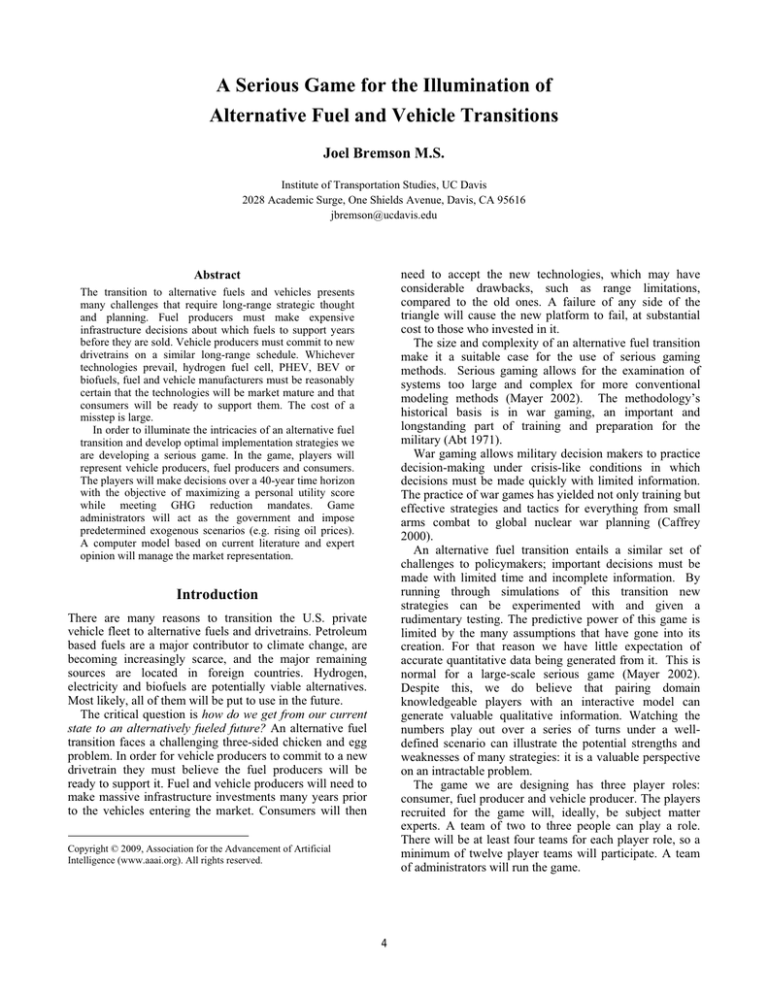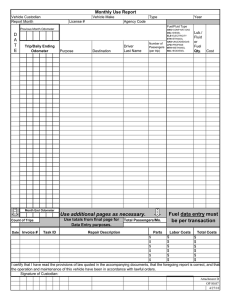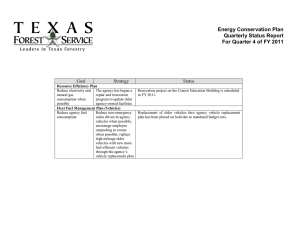
A Serious Game for the Illumination of
Alternative Fuel and Vehicle Transitions
Joel Bremson M.S.
Institute of Transportation Studies, UC Davis
2028 Academic Surge, One Shields Avenue, Davis, CA 95616
jbremson@ucdavis.edu
need to accept the new technologies, which may have
considerable drawbacks, such as range limitations,
compared to the old ones. A failure of any side of the
triangle will cause the new platform to fail, at substantial
cost to those who invested in it.
The size and complexity of an alternative fuel transition
make it a suitable case for the use of serious gaming
methods. Serious gaming allows for the examination of
systems too large and complex for more conventional
modeling methods (Mayer 2002). The methodology’s
historical basis is in war gaming, an important and
longstanding part of training and preparation for the
military (Abt 1971).
War gaming allows military decision makers to practice
decision-making under crisis-like conditions in which
decisions must be made quickly with limited information.
The practice of war games has yielded not only training but
effective strategies and tactics for everything from small
arms combat to global nuclear war planning (Caffrey
2000).
An alternative fuel transition entails a similar set of
challenges to policymakers; important decisions must be
made with limited time and incomplete information. By
running through simulations of this transition new
strategies can be experimented with and given a
rudimentary testing. The predictive power of this game is
limited by the many assumptions that have gone into its
creation. For that reason we have little expectation of
accurate quantitative data being generated from it. This is
normal for a large-scale serious game (Mayer 2002).
Despite this, we do believe that pairing domain
knowledgeable players with an interactive model can
generate valuable qualitative information. Watching the
numbers play out over a series of turns under a welldefined scenario can illustrate the potential strengths and
weaknesses of many strategies: it is a valuable perspective
on an intractable problem.
The game we are designing has three player roles:
consumer, fuel producer and vehicle producer. The players
recruited for the game will, ideally, be subject matter
experts. A team of two to three people can play a role.
There will be at least four teams for each player role, so a
minimum of twelve player teams will participate. A team
of administrators will run the game.
Abstract
The transition to alternative fuels and vehicles presents
many challenges that require long-range strategic thought
and planning. Fuel producers must make expensive
infrastructure decisions about which fuels to support years
before they are sold. Vehicle producers must commit to new
drivetrains on a similar long-range schedule. Whichever
technologies prevail, hydrogen fuel cell, PHEV, BEV or
biofuels, fuel and vehicle manufacturers must be reasonably
certain that the technologies will be market mature and that
consumers will be ready to support them. The cost of a
misstep is large.
In order to illuminate the intricacies of an alternative fuel
transition and develop optimal implementation strategies we
are developing a serious game. In the game, players will
represent vehicle producers, fuel producers and consumers.
The players will make decisions over a 40-year time horizon
with the objective of maximizing a personal utility score
while meeting GHG reduction mandates. Game
administrators will act as the government and impose
predetermined exogenous scenarios (e.g. rising oil prices).
A computer model based on current literature and expert
opinion will manage the market representation.
Introduction
There are many reasons to transition the U.S. private
vehicle fleet to alternative fuels and drivetrains. Petroleum
based fuels are a major contributor to climate change, are
becoming increasingly scarce, and the major remaining
sources are located in foreign countries. Hydrogen,
electricity and biofuels are potentially viable alternatives.
Most likely, all of them will be put to use in the future.
The critical question is how do we get from our current
state to an alternatively fueled future? An alternative fuel
transition faces a challenging three-sided chicken and egg
problem. In order for vehicle producers to commit to a new
drivetrain they must believe the fuel producers will be
ready to support it. Fuel and vehicle producers will need to
make massive infrastructure investments many years prior
to the vehicles entering the market. Consumers will then
Copyright © 2009, Association for the Advancement of Artificial
Intelligence (www.aaai.org). All rights reserved.
4
The administrators will run the mechanical aspects of
the game and serve as referees. The administrators will
interact with the players in a non-player role as the
government. Each will have designated government
responsibilities such as utility regulation. They will also
introduce exogenous elements to further the pre-planned
scenario.
Players will be located in the same room. They will
make decisions about what cars to build, which fuels to
produce, and which to buy using in-person negotiation.
The players will enter decisions into a web-based interface
using a hybrid turn-based structure. All players will act
simultaneously in turns (or rounds) lasting ten to fifteen
minutes.
Certain aspects of the game, such as vehicle purchases,
will occur in real time on a first come first served basis
during the turn. Vehicles are one of the few products that
consumers expect to negotiate over. We wanted to capture
some of that in the game. Fuel, alternatively, is purchased
for the consumer automatically at the end of the turn. Fuel
is a commodity product. Making consumers manually buy
their own fuel adds tedium without benefit. At the turn’s
end the computer model will process the player decisions
and report the results, after which a new turn will begin. A
game will consist of ten to twenty turns, with each turn
representing two or four years. A post analysis session will
follow the game.
The results of serious games can be surprising; games
often uncover unexpected results. The result of obvious
interest is the dominant fuel(s) at the end of the game? Did
the players achieve a significant GHG reduction? What
were the policies that promoted change? Which ones
prevented change? The game will serve as a policy
laboratory for examining how sustained chains of decisions
play out over time.
government. Working with the other players they can
implement various incentive policies to help the players
achieve their cooperative goals.
Consumers represent a large class of vehicle purchasers
who share common characteristics. The classes vary in
size, income level, vehicle feature preferences and vehicle
miles traveled per year (VMT). Each consumer has a
preference profile. Possible consumer classes include
budget-style, greens, high VMT and premium.
Consumers will receive a budget each turn for vehicle
expenses. Subtracted from that budget will be the fuel bill
for the last turn. Consumers will be able to express some
preferences about their fuel purchases but the refueling
itself will be automated based on the consumers’ fleet
makeup and VMT preferences. The consumer will also
receive information on the number and types of
replacement vehicles to buy.
The consumer will spend a portion of his turn shopping
for and purchasing vehicles. He is free to use spreadsheet
software, as are all other players. In addition to selecting
new vehicles the consumer will also interact with fuel and
vehicle producers to help inform their product building
decisions.
Consumers will also be able to make limited changes to
their VMT demands during each turn. This simulates the
consumer deciding to reduce driving and/or make
alternative mode choices. The consumer can choose to
accept a utility penalty (or bonus) for reducing (or
increasing) his VMT demand. The cost of behavioral
changes will depend on the current VMT level of the
consumer. Reducing VMT will lower the consumer’s fuel
costs on the next turn. It will also become a learned change
for the consumer; the new VMT demand will become the
consumer’s new base demand on subsequent turns.
Vehicle producers represent large (quantity) vehicle
manufacturers. To minimize complexity vehicle
producers are limited to producing up to six vehicles all of
which four to six seat passenger cars. Vehicle producers
select vehicle size, performance, style and drivetrain (e.g.
hybrid, battery electric, hydrogen fuel cell). Vehicle
producers improve their technology by investing in
drivetrain research. The drivetrain models were developed
using PSAT, a research and industry standard vehicle
modeling software.
Vehicle producers interact with fuel producers to make
sure the right types and quantities of fuels will be available
to support the vehicles they produce. They also work with
consumers to develop and refine their product lines. The
vehicle producer also negotiates with the government
(administrators) on incentives and mandates introduced in
the scenario. The vehicle producer’s score will primarily
be based on profitability.
Fuel producers represent large refining and
distribution companies. Fuel producers buy resources
such as petroleum, natural gas and biofuel feedstocks.
They decide which fuels to produce, how much and by
what process to produce them. They decide to build,
Game Description
Objectives
There are two objectives players must attempt to meet
during the game. The first is a cooperative objective, the
second a competitive one. The cooperative objective is to
meet a mandated reduction in oil use and GHG emissions.
GHG reduction goals are expected to be common in future
legislation. The second objective is competitive: players
must attempt to maximize a personal utility score. The
utility score serves as a guide to rate the players actions
and assist him in staying in character.
Player Roles
Administrators run and referee the game. Prior to the
game administrators decide on the game scenario. Based
on the scenario decision they configure the player roles and
preset their attributes. During the game the administrators
start and end turns, referee player disputes and introduce
scenario elements. The administrators act as the
5
maintain and shut down refineries. They also make
decisions on their fuel distribution networks. As the
vehicle fleets transition to higher levels of electric drive
fuel producers can invest in electricity production.
Fuel producers will invest in fuel production technology
research in order to reduce production costs and meet
government regulations. The challenge for fuel producers
is the lead-time required to put a new refineries and
distribution systems on line. They must make sure that
consumers and vehicle producers will support their
decision years in the future or they can be stuck with
worthless investments.
literature and expert input. Secondary models, of which
there are many, should be designed with the primary goal
of not distorting the output of the central models. A
guiding rule for the development of secondary models is
that they be order preserving in nature.
The Institute of Transportation Studies at UC Davis
(ITS-Davis), sponsor of this project, has unique
qualifications for testing and calibrating the realism of the
game’s models and model interactions.
ITS-Davis
researchers cover every aspect of vehicle and fuel markets.
These aspects include consumer behavior, transportation
and resource economics, vehicle technologies, fuel
technologies, energy, air pollution and GHG policy. ITSDavis is also able to recruit qualified players in industry
and government once the game is completed.
The game is being implemented using Ruby on Rails
(RoR), an open source web application framework. Ruby,
the base language of RoR, is a popular object oriented
(OO) scripting language in which it is easy to embed C for
performance sensitive functions. RoR imposes a modelview-controller (MVC) structure onto projects. The
combination of the OO scripting language and the MVC
code structuring requirements should make maintaining
and modifying the game system software as simple as
feasibly possible.
Player teams will each have their own networkconnected computer. They will enter their game decisions
into a browser-based interface. MySQL is being used for a
database. The R statistics software package is used to
preprocess models where possible in order to minimize
game time processing demands. Players are free to use any
other software they think might assist them. Many will
probably want to use a spreadsheet.
Game Methodology
In preparation for designing and building this game I
looked to the literature available on serious gaming. Most
of the academic literature on serious gaming comes from
researchers in Europe. The most useful reference text I
have found is Games in a World of Infrastructure (Mayer
2002). This text documents provides useful theory and case
studies of a number of serious games with infrastructure
themes. Also of use has been the International Simulation
and Gaming Association’s (ISAGA) conference
proceedings (e.g. Crookall 1986). A quality serious game
is a labor-intensive undertaking. It is important to
understand how serious games are currently used and what
can and cannot be accomplished with the technique.
One of the biggest challenges in designing a serious
game based on a large-scale infrastructure problem is
model scoping. Models must be selected with care. An
incorrect or overly complex model can obscure more
information then it ends up providing. At this point in
development there are five discrete sub-models in our
game: vehicle building, experience curves, consumer fuel
purchases, consumer fleet demand/attrition and fuel
refining. Our strategy is to focus on accuracy and realism
for these critical models and to build or include any other
required models so as not to cloud the output of the critical
models.
Many sub-models were considered and dropped from
the design. Fuel producers were initially going to have to
make decisions about oil exploration and extraction.
However this subject was found to be too complex to give
it proper coverage within the context of our game. The
price of oil, and other fuel feed stocks, will instead be an
exogenous factor. Fuel producers will compete based on
their decisions regarding refining and distribution
operations alone.
There is a limited amount of quality data that enters a
long-range predictive system. In our game the ordinal data
is important. We don’t know what vehicles thirty years in
the future will look like but we do know that certain
ordinal attributes of the technologies will likely remain
constant. For example, electric drive vehicles are more
efficient than vehicles powered by internal combustion
engines and should remain that way. The most important
models should be carefully developed using available
Game Goals
This is the first serious game project for ITS-Davis. As far
as we know, this is also the first use of the method for
studying alternative fuel transition issues. A central goal of
this project is to evaluate the suitability of the method for
our research field, transportation and vehicle technology.
Some key questions are:
x Is the information returned worth the substantial amount
of resources invested in the game?
x Can the serious game process be integrated productively
into our research program?
x How can we improve the process for our purposes?
The game is intended to be a policy experimentation
laboratory. Serious games should not be looked to for
specific, quantitative predictions. Their results tend to be
more qualitative, directions of trends rather than precise
numbers. The value of a serious game is that it enables a
unique type of discourse amongst a knowledgeable group
of players. Provided that the game mechanics present a
plausible reality players can explore the effects of a
sequence of actual decisions over time. It is a different
6
style of interaction than reports and meetings and thus
yields a different experience and outcome.
Of particular interest to us are possible solutions to the
chicken and egg problems of an alternative fuel transition.
Resolving this issue will likely be most efficient with some
sort of government intervention since the risks are
probably too large for private industry to undertake on
their own. However market interventions must be handled
carefully. Policy decisions on infrastructure have long
lifetimes and many unforeseen implications. The game
will hopefully illuminate some of the risks associated with
various policies.
Feebates are one policy option that will likely be
explored in the game. Feebates are a transfer tax. A fee is
placed on a item that is to be discouraged (e.g. SUVs) in
order to provide a rebate on an encouraged substitute (e.g.
economy cars). Feebates seem like a great idea prima
facie, however they must be implemented with care
because they can have serious counteracting effects
(Peters, Mueller et al. 2008).
Mayer, I., Veeneman, W. (2002). Games in a World of
Infrastructure. Delft, Eburon Academic Publishers.
Peters, A., M. G. Mueller, et al. (2008). "Feebates
promoting energy-efficient cars: Design options to address
more consumers and possible counteracting effects."
Energy Policy 36(4): 1355-1365.
Ruth, M., Bernier, C. Meier, A. Laitner, J. (2007).
"PowerPlay: Exploring decision making behaviors in
energy efficiency markets " Technological Forecasting and
Social Change 74(4): 470-490.
Conclusion
We are developing a serious game to examine the subject
of an alternative fuel transition. Game players will
represent consumers, vehicle producers and fuel producers.
Game administrators will run the game, play the role of
government and introduce exogenous elements into the
game in accordance with a pre-planned scenario. The game
outcomes are based on player interactions in combination
with computer model results.
The game is intended to be a policy experimentation
laboratory. Players will be given the opportunity to test out
policy options in a risk free environment. This will
hopefully lead to improved policy outcomes.
The game is the dissertation project of Joel Bremson.
His advisors are Joan Ogden, Alan Meiers, Cynthia Lin
and others. The game is currently on schedule to begin
play testing in Winter 2009.
References
Abt, C. C. (1971). Serious games. New York, Viking
Press.
Caffrey, M. (2000). "Toward a History Based Doctrine for
Wargaming."
Retrieved April 23, 2008, from
http://www.airpower.maxwell.af.mil/airchronicles/cc/caffr
ey.html.
Crookall, D., Greenblat, C., Coote, A., Klabbers, J.,
Watson, D. (1986). Simulation -- Gaming in the late 1980's
- Proceedings of ISAGA's 17th Intl. Conference.
International Simulation and Gaming Associations 17th
International Conference, France, Pergamon Press.
7



